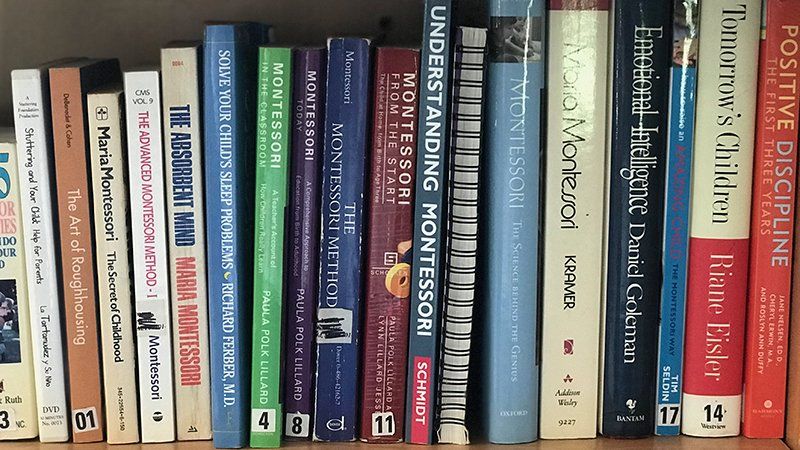150 Years: Books for Adults

This article is part of a series that we will share throughout the 2020-2021 school year to celebrate the 150th birthday of Dr. Maria Montessori. Check back often for more posts that reflect on the past, present, and future of Montessori education.
Each month we share a list of books we recommend for families who are searching for new titles. These lists are usually composed of children’s books, but this month we decided we would share books for adults instead. Whether you’re considering Montessori for your child for the first time or are a seasoned parent who wants to learn more, we’ve got you covered.
Before you go out and purchase books for yourself, check in with us. We may have a copy to lend you!
By Dr. Montessori
Dr. Montessori herself wrote quite a few books. There are also many published books that are transcripts of talks she gave across the globe. Reading her words directly is inspiring and interesting; bear in mind they were written a century ago and the language is a bit heavier than what we are used to today!
What You Should Know About Your Child
This book was created specifically for parents. One of the most foundational pillars of Montessori education is a deep understanding of human development. This book aims to reflect on the different aspects of growth and development in young children. An invaluable resource!
The quintessential text explaining the development of our most foundational period of life: the early years. Young children explore their world, learn to socialize, and develop their personalities during this critical time.
To Educate the Human Potential
Interested in learning more about what Montessori has to say for children aged 6 to 12? This is your book!
This book gives plenty of great information about Montessori education and children ages 7 to 12, but it is also the text in which Dr. Montessori lays out her ideas for adolescents. She describes her vision for an “experimental school for social life” and details what that might look like.
About Dr. Montessori
Maria Montessori by Rita Kramer
This is biography about Montessori is comprehensive and very readable; it takes readers from Montessori’s childhood through to her death and presents the facts. Though it’s an interesting read, Kramer does not attempt to glorify Montessori or hail her as something more than she was. The truth is, she really was an extraordinary woman. This journey through her life is a great read.
The Method
Montessori: The Science Behind the Genius by Angeline Stoll Lillard
This book is a fantastic introduction for anyone who is new to the Montessori method or for those who are curious about its relevance today. Dr. Montessori was a scientist and a meticulous observer as much as she was a visionary. A century later, modern scientific research is confirming what she knew all along. Stoll Lillard discusses some of the most important foundational Montessori ideals, and examines how current studies support the work we do with children and learning.
Specifically for Parents
Montessori Madness! By Trevor Eissler
Interested in a direct explanation of Montessori education from a parent who’s been there, done that? Eissler’s book is well loved by parents, teachers, and trainers alike. Early on in the book he describes the day when he and his wife, unhappy with the prospect of traditional schooling and hesitant to abandon their own careers to pursue homeschooling, walked into a local Montessori school to observe. “A few days later we arrived at the school and met the director. She escorted my wife to one classroom and me to another, two of the possible classes that our kids would attend if we decided in favor of this school. I opened the door. My idea of what education should look like has never been the same since.”
How to Raise an Amazing Child the Montessori Way by Tim Seldin
Montessori educators complete intensive training in order to properly teach children how to use the specialized materials. But that doesn’t mean you can adopt the philosophy (and implement some materials of your own) at home. Seldin offers practical advice on how we might shift our home and parenting approaches to align more with Montessori ideals.
Montessori From the Start: The Child at Home, from Birth to Age Three by Paula Polk Lillard and Lynn Lillard Jessen
Infants and toddlers require special consideration when it comes to their development. Montessori for the youngest children incorporates the home in an important way. Lillard and Jessen, experienced Montessori educators and writers, provide simple and compelling ideas for parents to implement. Whether you’re wondering how to set up a Montessori bedroom or how to approach mealtimes, helpful tips will point you in the right direction.
The Montessori Toddler: A Parent’s Guide to Raising a Curious and Responsible Human Being
by Simone Davies
Davies enjoys a devoted following on her blog, The Montessori Notebook. Her recently published book on how to raise toddlers in a Montessori home has received overwhelmingly positive feedback. In it, she rejects the concept of the “terrible twos” and advocates for finding mutual respect, offers ideas for setting up your home in a way that fosters independence, and more.










